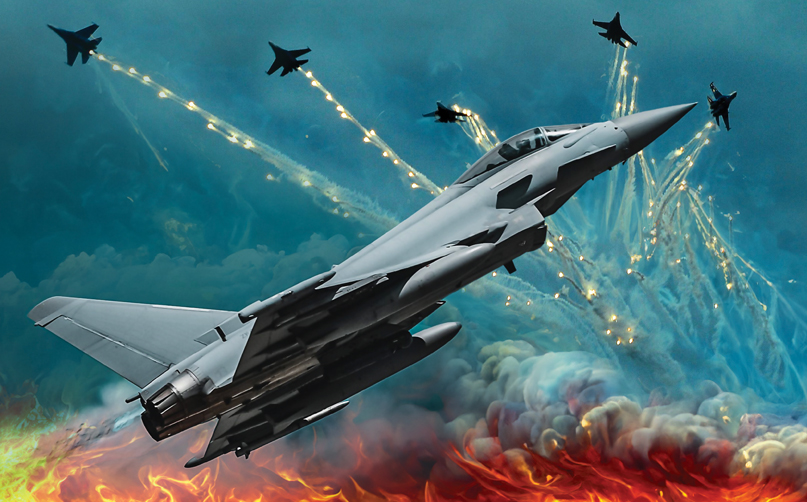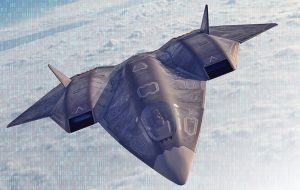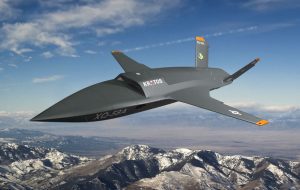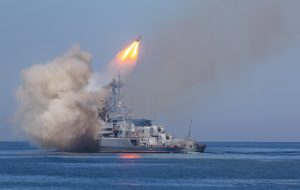Although air forces alone may not be sufficient to win a war, today a state cannot win a war without them. This explains the importance of the modern Air Forces’s philosophy, which is based on several factors, most notably the nature and scale of threats faced by states, the size and nature of expected air force missions and the states’ economic situations, political environments and strategic orientations. The Air Forces philosophy is undoubtedly reflected in all the criteria used to measure the strength of an air force, most importantly: the number and types of aircraft, number and proficiency of pilots and training locations.
Additionally, there is maintenance status and availability of spare parts and ammunition, air bases and airports, command and control methods and level of integration with other forces, especially ground forces, rules and methods for fuel and ammunition supplies, allies or supporters and capabilities to replace losses and limits and time required associated with that. These factors affect the operational advantage of air forces, which is the ability to detect, deter and defeat adversaries before they can do the same, by enhancing key attributes of air power such as range, speed and altitude. Sustainably improving these traits, along with making effective command and control decisions, facilitates achieving operational advantage.
Given current geostrategic tensions, fears and intensifying strategic competition, as well as escalating direct tensions or conflicts in multiple parts of the world in the Pacific and Indian Oceans, Middle East, and Europe, as well as the rise of violent extremist organizations and aggressive, expansionist behaviour of many adversaries, major armies now more than ever need combat-capable forces able to intervene globally on a wide scale and provide nimble combat support. Moreover, with the advent of supersonic long-range weapons and exploitation of the information environment in space and cyber domains, no one is safe anymore.
This fact increases the importance of a philosophy aimed at acquiring detection, deterrence, defence capabilities and the ability of air forces to defeat adversaries.
Key Principles of Modern Air Forces Philosophy
Combining support capability with the ability to conduct decisive independent operations: On the other hand, the Air Forces’ philosophy is fundamentally based on that of the army they operate within, which determines the role of air forces: Is it within the framework of integrated warfare centred around air support to other forces, mainly ground forces, and rapidly achieving air supremacy on the battlefield as part of the “manoeuvre warfare” doctrine? Or is it within the framework of using air power more independently in stand-alone operations, away from the traditional role of supporting ground and naval forces? Or should air forces be prepared to play both roles as needed?
Colonel John Warden’s theory is to strike and destroy the adversary’s centre of gravity in societies by targeting: enemy leadership, military forces, industrial capabilities, infrastructure and personnel.
Warden also says the most effective use is hitting all those targets to weaken the enemy’s will to fight, while focusing on leadership, which if eliminated, paralyzes the rest of the military structure, creating chaos in command and control capabilities, leading to the enemy’s collapse and surrender.
Warden’s theory aligns with technological developments in smart munitions and military information systems, leading to philosophies envisioning the possibility of decisive military victory solely by air power in some contexts to achieve what the Italian general Giulio Douhet envisioned, that a day will come when adversaries will be forced to surrender by air power alone without ground or naval operations.
Expanding manoeuvre space for air forces: General Alex Grynkewich, commander of the US Air Force’s 9th Air Force and air component commander at US Central Command summarizes the mission of the United States Air Force as fly, fight and win with the ability to bring air power anywhere in the world at any time.
“The United States’ ability to rapidly deploy major combat power like a 5th generation fighter squadron to the Middle East is reassuring to our regional partners. While there are fewer ground forces stationed overseas compared to previous years, we retain the ability to swiftly flow additional forces from outside the region if needed,” Grynkewich explained.
Despite the reduction of US forces in various parts of the world, it has maintained a network of air bases worldwide, enabling it to rapidly deploy large numbers of aircraft anywhere around the world.
Additionally, the US has developed a sustainable global logistics system for its globally positioned air forces.
In a study on American air operations, Chinese military analysts discussed learning from the US experience and building on it to develop their air forces in line with geopolitical ambitions.
As China’s economic and security interests continue expanding beyond its immediate borders, Chinese commanders have tasked the People’s Liberation Army Air Force with developing strategic capabilities to support and protect its far-seas maritime activities, especially in the Pacific Ocean.
In a 2015 speech, People’s Liberation Army Air Force Commander Ma Xiaotian said China’s overseas economic expansion and military non-combat operations are growing day by day, so properly recognizing the pressing need to prepare for maritime military struggle is necessary. He added that China’s global geopolitical expansion will ultimately require the People’s Liberation Army to adapt its philosophy, especially regarding air power, to develop capabilities fitting new tasks in unexpected and uncertain environments. In this context, we can understand why China’s aircraft carrier Shandong has crossed the Taiwan Strait several times in recent months, causing Taiwanese and Japanese apprehension about China expanding maneuver space for its air forces.
In 2022, China launched its first domestically designed and built aircraft carrier, which will be able to deploy up to 70 aircraft, including J-15 fighters and Z-9C anti-submarine helicopters. This new philosophy has alarmed the US Air Combat Command leader, who warned China’s military arsenal has entered a “dangerous area”, saying “the military infrastructure they are building today to defend their interests is designed to inflict a greater number of casualties in the first 30 hours of any future conflict than we have witnessed in the last 30 years in the Middle East”.
The Pentagon also stated China is developing better stealth fighters, and manned and unmanned aircraft squadrons, as well as deploying more mature air combat capabilities and a range of unmanned aerial vehicles, from hand-held units to large RQ-4 Global Hawk class aircraft.
Bridging “Air” and “Space”: By definition, Air Forces operate in the air, allowing them to overcome natural obstacles and borders, however, unlike ground and naval forces, they cannot hold ground. Historically, the military exploited the part of the atmosphere at 25-125 km altitude, with higher altitudes reserved for spacecraft and satellites. Today, however, there are weapons exceeding this altitude like hypersonic aircraft and missiles, and unmanned aerial vehicles powered by solar energy. Moreover, the future will likely bring more spaceplanes and guided missiles bridging the air-space gap that existed in the 20th century. Perhaps the near future will witness more vehicles capable of penetrating the atmosphere, flying at high speeds and conducting warfare operations that most current air defences (except ballistic missile defences) cannot defend against. In this context, in 2020 the French Air Force changed its name to French Air and Space Force, just one year after establishing its Space Command on September 3, 2019. Then-Air and Space Force Chief of Staff General Philippe Lavigne stated: “Pilots today need to look up, farther, towards space, this new battlefield area which is increasingly becoming highly strategic”.
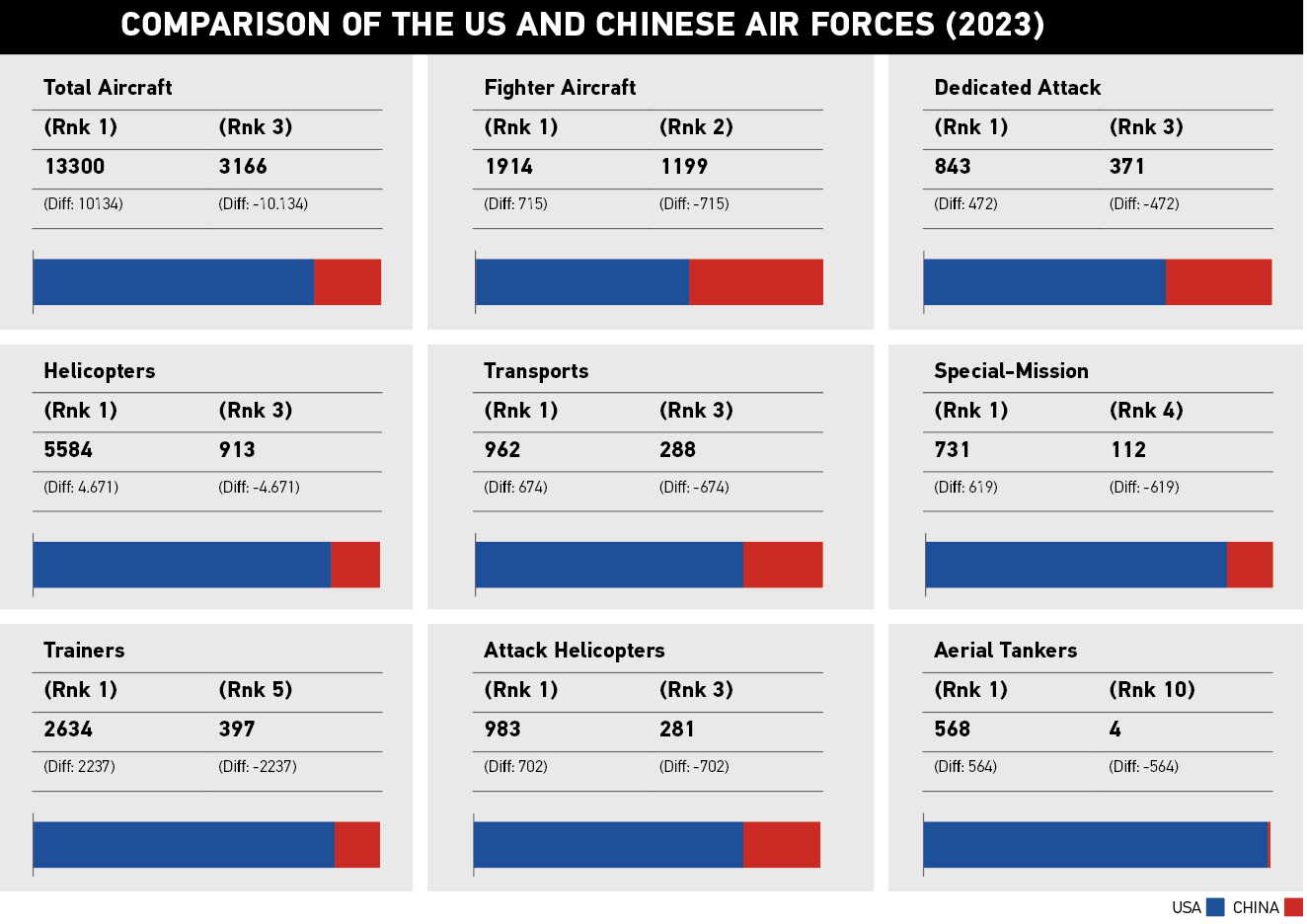
Controlling or at least operationally securing the electromagnetic spectrum for air forces: Major world powers are paying increasing attention to the need to control or at least operationally secure the electromagnetic spectrum for their operations, as the freedom to operate in the electromagnetic spectrum is a fundamental prerequisite for the speed and precision of air operations. It enables navigation systems, wireless internet, Bluetooth and thus all military operations. For example, the United States is concerned about the increasing investment of research institutes affiliated with the Chinese People’s Liberation Army in directed energy weapons that produce a powerful electromagnetic pulse to neutralize electronic systems within their effective radius. Such weapons are known as high-power microwave devices. Recent Chinese literature points to various applications of high-power microwave systems capable of shutting down enemy radars, jamming systems and the electronic systems of attacking aircraft and anti-radiation missiles.
Additionally, they can be used as an anti-satellite weapon by destroying sensitive electronic satellite systems.
The website of the Royal Canadian Air Force states that space capabilities are an integral part of its area of operations and that full access to space and freedom of operations within it despite congestion, competition and disputes over it is essential. The website of the Royal Canadian Air Force states that unhindered access to and exploitation of the electromagnetic spectrum is critical to conducting its military operations. It must succeed in contested electromagnetic environments beyond traditional or even cyber warfare by sustainably developing adaptable, evolved techniques for operating in a highly electromagnetically contested environment.
A more integrated approach with allied air forces and air and missile defence systems: In this regard, General Alex Grynkewich, commander of the US Air Force’s 9th Air Force and air component commander at US Central Command, says that the integration of air forces and regional air and missile defence systems has become more necessary than ever.
“This ensures that US and European allies’ deployed air defence assets in the region can be utilized along with the strong defensive capabilities of regional states,” Grynkewich said.
“The goal is to establish an overarching framework that ties these capabilities together, creating a unified operational picture. This integration is necessary to ensure strong, effective defensive operations. However, such integration requires technical solutions including radar systems, computer networks and communications systems that effectively enable interoperatability.
Moreover, it relies on a willingness among our allies and partners to share information and intelligence. By forming a cohesive regional defensive structure, we can contribute to greater long-term stability in the area,” he added.
In another theatre of international tensions and conflicts, Japanese Prime Minister Fumio Kishida expressed concern last November over recent joint flights by Chinese and Russian bombers near his country’s waters, warning that Japan faces a difficult and complex security environment.
Integrating emerging technologies to ensure future operational advantage for air forces: The philosophy underpinning the Royal Canadian Air Force, for instance, theorizes that the capabilities of the Royal Canadian Air Force need to evolve rapidly to ensure operational advantage (the ability to detect, deter and defeat adversaries before they can do the same) in air and space domains.
This is done by integrating and developing emerging technologies, given what that represents in protecting Canadian sovereignty and building credible exploratory capabilities, enabling the integration of the Royal Canadian Air Force with the joint force of the Canadian Armed Forces and the forces of Canada’s closest allies.
Emerging technologies create an environment requiring rapid and relevant defensive innovation. Thus, we need to take advantage of these technologies to create new capabilities and enhance state security. Consequently, the Canadian Air Force is working to leverage autonomous systems technology, artificial intelligence, machine learning, cloud systems, sensors and other innovative technologies.
This is to maintain a future operational advantage, given the major increase these technologies will provide in key areas for modern air forces, including command and control, intelligence, surveillance and reconnaissance, as well as processing, exploiting and disseminating data collected from air and space platforms.
The philosophy of the Royal Canadian Air Force theorizes that taking advantage of these technologies will enhance the speed and quality of decisions regarding operations execution, improve sustainability through applying data and analytics, improve pilot training systems and methodologies and better employment, thus simplifying or automating tasks.
These technologies will also allow the Royal Canadian Air Force to consider applying human-machine teaming in certain areas, such as manned and unmanned aerial vehicles, to increase operational impacts while improving manufacturing and acquisition costs.
On the other hand, the US Air Force has begun using artificial intelligence to aid in resource allocation and predict how one decision can reshape its program and budget.
For instance, if Air Force leaders were to add another squadron of F-35s, an AI-enabled resource allocation platform could immediately highlight not just the direct costs of the decision, but also its impact on personnel, bases, aircraft availability and other key aspects.
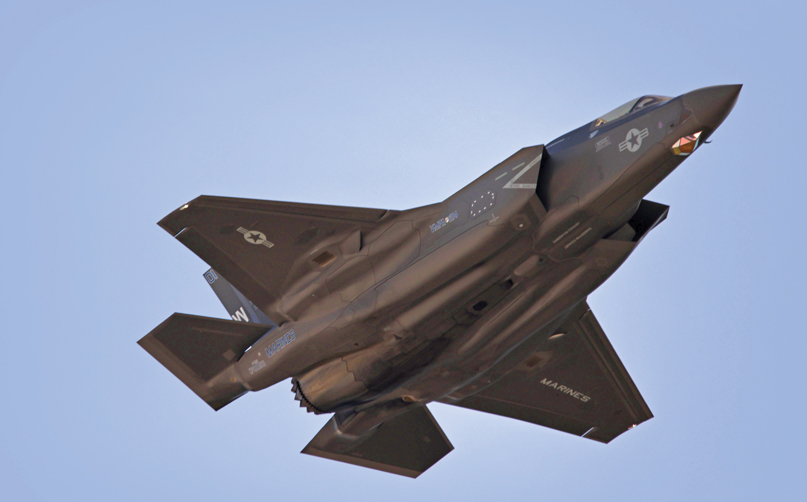
Efficiency in high-risk environments: US Air Force Deputy Chief of Staff Lt. Gen. Thomas Bussiere stated last November that US Air Force bases worldwide will face a much greater risk of attack in the future than during the Cold War.
He pointed out that the US military has learned how to prevent such attacks, due to the availability of multilayered air defence systems in some countries including anti-air laser weapons capable of dealing with various air threats including drones and satellites such as the Russian Peresvet system.
According to the US, recent images of four Chinese Air Force J-16 fighter jets have renewed speculation about what is believed to be the longest-range air-to-air missile in the world, the PL-XX, which was seen integrated into two jets.
This missile is estimated to have a range of 500 km or more, making it by far the longest-range air-to-air missile, allowing it to neutralize important air assets such as early warning aircraft, airborne control aircraft like the E-3 and E-7, and aerial refuelling tankers like the KC-135.
This would “dangerously” undermine for example the operations of the US Air Force in the Pacific region.
Integrating climate change into the air power approach: Knowing the impact of climate change on the performance or service life of air weapon systems is now a must. For instance, extreme heat in certain theatres of operation can damage engines or disrupt electronics, affect aircraft payload and range or pose risks to munition storage.
Deploying and operating air forces in harsh environments such as polar regions also requires adapting some equipment. In this way, modern air philosophies seek to identify climatic risks and their effects on operating conditions to ensure equipment and technological program performance and reliability, as well as develop their fighters’ capabilities to integrate climate change into the capability approach for both equipment and troops.
Thus, the US Air Force announced it would invest $235 million to help startup “Jet Zero” build a blended wing body aircraft to reduce fuel consumption and emissions with greater range and efficiency.
By the end of 2022, the US Air Force released a climate action plan aiming to establish military bases that achieve net zero emissions by 2046.
The plan also details how the US Air Force will need to adapt its operations to climate change, especially regarding its base infrastructure and energy sources. To achieve this goal, the plan allocated $36 million for 2023, with an increase of $100 million annually through the end of 2026.
Conclusion
This in-depth study shed light on the main features of modern air forces philosophy: combining support capability with the ability to conduct decisive independent operations; reaching the farthest range by expanding manoeuvre space for air forces; bridging “air” and “space”; controlling or at least operationally securing the electromagnetic spectrum for air forces; a more integrated approach with allied air forces and air and missile defence systems; integrating emerging technologies to ensure future operational advantage for air forces; Efficiency in high-risk environments; and integrating climate change into the air power approach.
As we have pointed out, the literature on air forces agrees that they are essential to victory in modern warfare and that they are the force capable of launching parallel attacks to create tactical, operational and strategic effects simultaneously. However, the literature differs regarding the most effective objectives in creating desired effects, what effects are targeted the most, and by what mechanisms will they be achieved. Answers to such questions may never be fully agreed upon, and that may be best. Air forces strategy philosophies have always benefited from conflicting studies and sustained intellectual debate to generate proposals, solutions and developmental approaches perhaps more than any other military branch.
» By: Professor Wael Saleh (Expert at Trends Research & Advisory Center)


